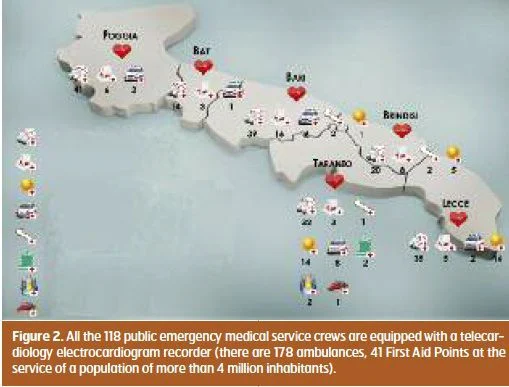HealthManagement, Volume 14, Issue 3 /2012
"Beam me up, Scotty" is a catchphrase that made its way into popular culture from the science fiction television series Star Trek. Thanks to his chief engineer Montgomery "Scotty" Scott, the commander, Captain Kirk, could be transported anywhere from the Starship Enterprise. We are, of course, interested in facts, not science fiction. How can a cardiologist be brought to wherever he/she is needed, without the aid of Scotty’s tele-beam? Telemedicine application in the field of cardiology has made this possible in Puglia. The region is currently served by a telemedicine hub from where cardiologists, available 24/7, report back on electrocardiograms recorded on a small pocket device, the CardioVox P12 TM (Aerotel, Holon, Israel), and transmitted by telephone (mobile or other).
How Does It Work?
The pocket recorder may record a complete 12-lead electrocardiogram in a couple of minutes; after telephone coupling, the ECG is sent to the telecardiology hub, which is located in Puglia’s capital city, Bari (Figure 1). Here, the cardiologist may read the ECG on a computer screen and report back on the findings; when necessary, a brief consultation may also occur between the on-site sender – a physician, paramedics or members of the public – and the cardiologist. Remote senders may receive back the ECG report on their smart-phone or iPad, or on a PC via an Internet or telephone connection. The electrocardiograms may be easily stored and printed as required.
The telecardiology hub, which serves the whole region, is operative 24/7; two cardiologists are on duty, and there are 12 computer terminals, 25 telephone lines and two call centre operators available 24/7. About 20 cardiologists are involved in providing the telecardiology service.
An emergency power system is ready in the case of electrical power outage. All the services and the entire network are shielded from virus threats by a combination of hardware and software firewalls, and a comprehensive antivirus suite capable of real-time scanning and updates, in addition to software back-up procedures. A comprehensive network management programme ensures that all systems have realtime updates and that the latest security patches are installed as soon as they are released.
All data is electronically stored onto computers using a unique identification number for centre and individual, under the provisions of the Italian Privacy and Personal Information Protection Act (D. Lgs. 196/2003).
The telecardiology service has been in operation since 2004 and is available for the “118” regional public emergency medical service, the national “911” medical emergencies service (178 ambulances and 41 First Aid Points are at the disposal of the more than four million inhabitants, Figure 2.) and hundreds of private customers (patients, pharmacies, general practitioners, specialists in occupational medicine, nursing homes).
In June 2012 the 500,000th electrocardiogram was analysed by the service, which is a particularly interesting example of synergy between public health authorities and private enterprise. The regional 118 service is run by the regional government while the telecardiology service is provided by Cardio-on-line Europe s.r.l., a private company.
The telecardiology service in Puglia is an extremely interesting example of how it is possible to reconcile the two main models of telemedicine delivery for cardiology emergencies: The Boston model, which involves only a small number of telemedicine providers, covers a small area and assigns the ECG analysis to paramedics; and the Los Angeles model, with a larger area but a large number of telemedicine providers and a computer-algorithm- based ECG report. The Puglia model provides not only qualified, remote, on-site assistance from a cardiologist – as is required by Italian law for electrocardiogram analysis – but also cost reduction: A single telemedicine hub may potentially support even more than one region with several million inhabitants.
The Evidence
Several studies have shown that telemedicine support can improve the quality of medical assistance and reduce cardiovascular mortality. International guidelines as well as other consensus and scientific statements recommend that emergency medical service acquires and uses pre-hospital ECGs to evaluate patients with suspected acute coronary syndrome.
Transmission of a pre-hospital 12-lead ECG directly to the attending cardiologist's mobile telephone decreased door-to-PCI time by >1 hour when patients were transported directly to PCI centres, bypassing local hospitals. In referred patients, median time from 911 call to PCI was significantly shorter than in the control group (74 vs 127 minutes; p <0.001); accordingly, door-to-PCI time was 63 minutes shorter for referred patients versus controls (34 vs 97 minutes; p <0.001). In another study assessing the diversion of ST-elevation myocardial infarction patients for primary angioplasty based on wireless pre-hospital 12-lead electrocardiographic transmission directly to the cardiologist's handheld computer, hospital arrival to procedure start was 40 minutes, compared with 94 minutes in a historic control group (p<.01).
At a local level, in Puglia, for over 233,657 subjects with suspected acute heart disease who were screened over a period of six years using pre-hospital ECG through telemedicine support, 45% of electrocardiograms were abnormal; of these, 18% showed signs suggestive of acute coronary syndrome, 20% were indicative of arrhythmia, and minor problems emerged in 62% of cases. In cases of suspected acute coronary syndrome, ECG findings were normal in 77% of patients; 74% of subjects with suspected acute coronary syndrome were screened within 30 minutes from the onset of symptoms.
In another study, ECG showed signs of ST-elevation in only 3.84% of patients with acute chest pain, while only 78.94% of patients with ST-elevation acute myocardial infarction reported acute chest pain. The diagnosis was therefore based mainly on ECG findings with telemedicine pre-hospital electrocardiograms despite the presence of atypical clinical presentation. About two thirds of patients with STelevation acute myocardial infarction were resident in small towns without coronary care units, and thus particularly benefitted from an immediate pre-hospital diagnosis.
Telecardiology pre-hospital ECG screening could significantly help in avoiding errors and delay in STEMI diagnosis in elderly patients. Among STEMI patients older than 70 years, atypical presentation was detected in 32% [95% confidence interval (CI): 26.8-38.1] of patients (vs. 11% 95% CI: 7.8-15.5, P<0.001). The rate of atypical STEMI presentation, immediately diagnosed, thanks to telecardiology, rose from 9.2% (95% CI: 5-17%) in the 60-69 years age range to 25.6% (95% CI: 20-35%) in the 70-79 years age range, to 35.2% (95% CI: 26-45%) in the 80-89 age range, and to 46.1% (95% CI: 26-67%) in patients older than 89 years of age (P<0.01 in all cases). The number needed to treat (to avoid a single missed STEMI diagnosis) was 9.4 (95% CI: 6.4-12.9) for patients younger than 70 years, versus 3.1 (95% CI: 2.6-3.7) among those older than 70 years (P<0.001).
Telecardiology support may also improve the sensitivity of diagnosis of atrial fibrillation with atypical presentation in elderly patients. In a cohort of emergency medical service patients, the rate of subjects with atrial fibrillation and typical symptoms significantly decreased with age (<65 years 29.58%, 65-75 years 17.06%, >75 years 10.35%, p < 0.001). The number needed to diagnose an atrial fibrillation with atypical presentation (number needed to treat) decreased from 45 (<65 years) to 9 (65-75 years) and 5 (>75 years) (p < 0.001). Telecardiology support increased the rate of at-home diagnosis of AF from two-fold (in 40-year-olds) up to four-fold (60-year-olds) and seven-fold (70-year-olds).
The Final Frontier
Telecardiology is now established in Puglia. Several studies of primary and secondary prevention, also with the support of pharmacies, have been carried out. In the CAPITAL (CArdiovascular Prevention wIth Telecardiology in Puglia) study, ten thousand patients are currently involved in a project to estimate cardiovascular risk in a Mediterranean population and to draw charts of cardiovascular risk in a Mediterranean context. Screening studies for early ECG diagnosis of cardiovascular disease among primary and high school students and professional athletes are currently in the advanced planning phase. Further initiatives will probably be useful in the future in reducing waiting lists for electrocardiogram examinations in public regional hospitals.
Conclusions
Telecardiology allows for the remote specialist interpretation of electrocardiographic recordings via telephone transmission, and can help support general practitioners in the diagnosis and management of acute and chronic cardiac disease, as well as provide the potential for screening opportunities in patients at particular risk. According to some authors’ analysis, telecardiology is set to revolutionise cardiac care in the community, leading to a reduction in costs and bridging the gap between primary and secondary care.
The Puglia telecardiology network provides an interesting demonstration of telemedicine potential in healthcare management, reconciling high quality of medical assistance with optimal spending of public resources.


References:
References available upon request,

![Tuberculosis Diagnostics: The Promise of [18F]FDT PET Imaging Tuberculosis Diagnostics: The Promise of [18F]FDT PET Imaging](https://res.cloudinary.com/healthmanagement-org/image/upload/c_thumb,f_auto,fl_lossy,h_184,q_90,w_500/v1721132076/cw/00127782_cw_image_wi_88cc5f34b1423cec414436d2748b40ce.webp)




